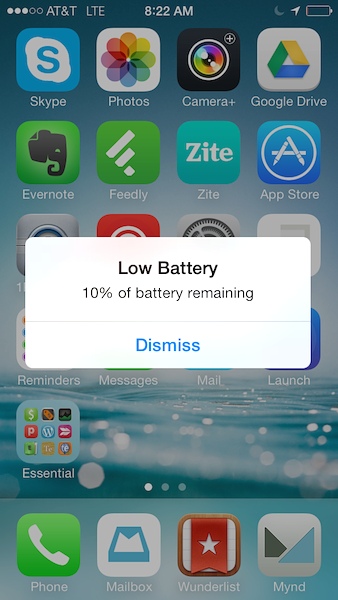
NEWS & UPDATES
10 Tips to Help Battery Life
Battery life. It’s something we all consciously and subconsciously think about with all our devices but especially our phones. There’s nothing like that sinking dreadful feeling you get when you look down at your phone and it’s less than 20% and you have no way to charge it. This post will give you tips on how what to do in that scenario as well as how to get your battery to last longer day-to-day and also how to extend the life of your battery.
Similar to having a view to manage your storage, iOS has a menu to view your battery usage. This menu shows you what apps have used the most battery in the last 24 hours as well as over the last 7 days. From here it will give you a good idea of where a good portion of your battery is going, exactly how much of your battery is being drained from all that Facebook browsing.
Getting to this menu is easy, simply go to Setting>Battery. Once the menu loads it will order the apps by percentage battery used. Next to “Last 24 hours / Last 7 days” there is a little clock, tap this to activate a more detailed menu showing time on screen and time in the background.
1. Background App Refresh
If you take anything away from this article hear this: **Stop force closing all your apps.** This is a huge myth that has perpetuated over time from person to person and is actually worse for your battery then just leaving them be. Not to be too detailed about it but almost immediately when you leave an app it goes in to a deep freeze. If you launch it back up soon after it will pick up where you left off as it is loaded into your phones RAM. Otherwise if you don’t use it for a while it goes away on it’s own.
The real battery drain is a feature called “Background App Refresh” which does what it sounds like, it launches an app in the background so it stays up to date when you want to open it. Sounds great unfortunately it allows many apps significant power drain. To turn this feature off simply go to Settings>General>Background App Refresh and from there you can toggle it off for individual apps or off altogether.
2. Mail Fetch
Having your e-mail accounts on your device can be super convenient (or a little annoying always having e-mails pop up). The more mail accounts you have and the more often they are updating the more your battery drains. To change the retrieval settings for the mail accounts go to Settings>Mail>Accounts>Fetch New Data. The option that uses the least amount of battery will be setting ‘Fetch’ to ‘Manual’. When you set this option your phone will only check for mail when you launch the mail app.
If the option for ‘Push’ is available that is generally not too battery intensive. Instead of the phone check with the e-mail server to se if there is any new mail, the e-mail server will just send the mail to the phone when it arrives. If ‘Push’ is not available then you will want to set ‘Fetch’ as least often as possible.
3. Location Services
Location services are a very useful feature, I for one use an app called Waze very day to see if there is traffic along my route to and from work. Different apps use your location to give you recommendations based on where you are. To manage location services go in to Settings>Privacy>Location Services and from here you can manage when or even if certain apps are able to access you location.
At the bottom of the menu there is a menu called System Services. From this menu you can toggle system location services su as location based ads. Some of these you will want to leave on such as setting time zone. One last menu deeper is an option that is a pretty big battery drain, ‘Frequent Locations’. Turn this off and it will help your battery life pretty drastically.
4. Display Settings
Just having your display on at all drains your battery, the screen and backlight draws more power than almost anything else on the phone. Keep your phones backlight as low as tolerable to save much battery power. Have your phone set to lock in as short a time as possible. These options can be managed under Settings>Display and Brightness.
One more display setting you can turn off to save battery will be a personal preference. This setting will turn off a lot of the fancy transition graphics going from app to app and back to the home screen. To turn this off go to Settings>General>Accessibility>Reduce Motion.
5. Push Notifications
Getting push notifications all the time can be a big battery drain. Piggy-backing on the screen draining power, every time you get a notification your screen turns on which drains just a little more power. To manage what apps get notifications and where you see them go to Settings>Notifications. From you here you can turn notifications on or off, set whether they appear in the lock screen or see how they appear on the screen, as banners or pop-ups.
6. Spotlight Indexing
Your iPhone keeps an index of all your devices contents, e-mails, messages, contacts, everything. Every so often your iPhone will re-index to check for anything new, any changes. Unfortunately there is no way to straight up disable Spotlight but you can choose what it indexes. Simply go in to Settings>General>Spotlight Index and you can turn off whichever apps you don’t need to be able to search through.
7. Data Network
Without data your phone would be nearly useless but your phone uses a different amount of power depending on whether it’s using wifi of LTE. Using your phone on wifi will use the least amount of battery and using your phone on LTE will use the most amount of battery. (Using your phone on wifi will also use less of your phones data plan, but that’s a story for another time.)
When you are out and about and are not using wifi, it is best for battery life if it is turned off and not searching around for networks to join. Worst case scenario if you need to drain every ounce of power from your draining battery it is also recommended to turn off your LTE. You can do this by going to Setting>Cellular>Cellular Data Options and toggle LTE off.
8. Low Power Mode
This is an option you can enable sooner but will automatically prompt you when you get down to 20%. Low Power Mode is a battery saving mode you can put your phone in to. It will automatically disable a few power hungry background features (most of which are listed above). According to Apple, low power mode limits the following features:
- Email fetch
- "Hey Siri”
- Background app refresh
- Automatic downloads
- Some visual effects
- Auto-Lock (defaults to 30 seconds)
9. Ambient Temperatures
Batteries can be greatly affected by ambient temperatures, too cold and it can’t work, too hot and it drains quickly. If you’re ever had you phone out in the winter and it turned off before it ran out of battery, this is why. The recommended operation temperatures for an iPhone are between 32º to 95º F. Your iPhone battery heats up while charging, too. To keep it cooler while charging it is recommended to take it out of it’s case, the case can insulate the phone and trap heat allowing the phone to get warmer than it should.
10. Charging Habits
Speaking of charging, there are some habits to follow to get the most life out of your battery. First and foremost, only use Apple approved charging cables and charging blocks. Typically, Apple approved equipment follows what Apple classifies as MFI or Made For iPhone. Low quality and cheap stuff can cause major problems, even going so far as to short out your phone causing it to catch fire. Now that rarely happens but you still want to be careful.
Another thing you can do to help the longevity of your battery is to let it drain as much as possible (down to below 10-20%) and leave it on the charger until it get’s back up to 100%. Now, it is not necessary to do this every time, battery technology has greatly improved over the years. If you need to occasionally only charge it a bit to top it off, go right ahead.




